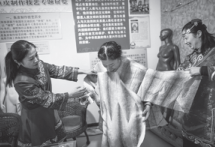Fish-skin garments weave a new story

TONGJIANG, HEILONGJIANG PROVINCE-At 68 years old, You Wenfeng, who belongs to the Hezhe ethnic group, is one of the few people in her community who can still make clothing from fish skin. She was not born when her kinsmen were thrown into labor camps during Japan's occupation of Manchuria in the 1930s and 1940s.
"Many Hezhe clans perished, but my mother survived to pass on her fish-skin knowledge to me," says You.
A Tungusic people native to Siberia and on the Black Dragon River, as the Amur is known in China, the Hezhe rebuilt its population to 5,000 from 300 after World War II.
But that hasn't stopped the decline of Hezhe culture, including the tradition of making garments from the skin of carp, pike and salmon.
Few of the current generation are interested in learning the craft, as fish-skin clothing is also no longer a regular part of daily Hezhe attire.
Sensing the end, You started to impart her knowledge to some local women in Tongjiang, a quiet city near the northeastern border with Russia where she now lives.
Her disciples also learn the Yimakan, a storytelling genre that switches between speech and song in the Hezhe language.
The education is arduous, with You's acolytes committing to memory songs of fishing, hunting and ancient tribal conquests through phonetics alone.
Hezhe hunters rode on canoes made from birch, or "swift horses", You says, smiling. Such is their skill on water that legend says the Hezhe descended from mermaids.
These days, fish are sourced from the marketplace. And instead of tiger bone and deer tendon, embroidery needles and cotton thread are used.
A top and a pair of trousers for a woman require 50 fish, and for a man, 56, You says.
She would de-skin the fish and dry it. It is then repeatedly passed through the wooden jaws of a rudimentary press to soften it. The process takes a month. Sewing requires a further 20 days.
Finding commercial functions for fish-skin might save the craft. Fish-leather has inspired some luxury fashion houses such as Dior and Prada to occasionally include it in their garments and accessories, but the fabric is still largely a curiosity.
"Look at the criss-cross pattern on the skin," You said.
"It's stronger than most skins."

Today's Top News
- Ukraine says latest peace talks with US, Europe 'productive'
- Asia's rise and Europe's structural decline
- Economic stability a pillar of China's national security
- Xi taps China's deep wisdom for global good
- New rules aim for platforms' healthy growth
- Chinese web literature grows overseas






























